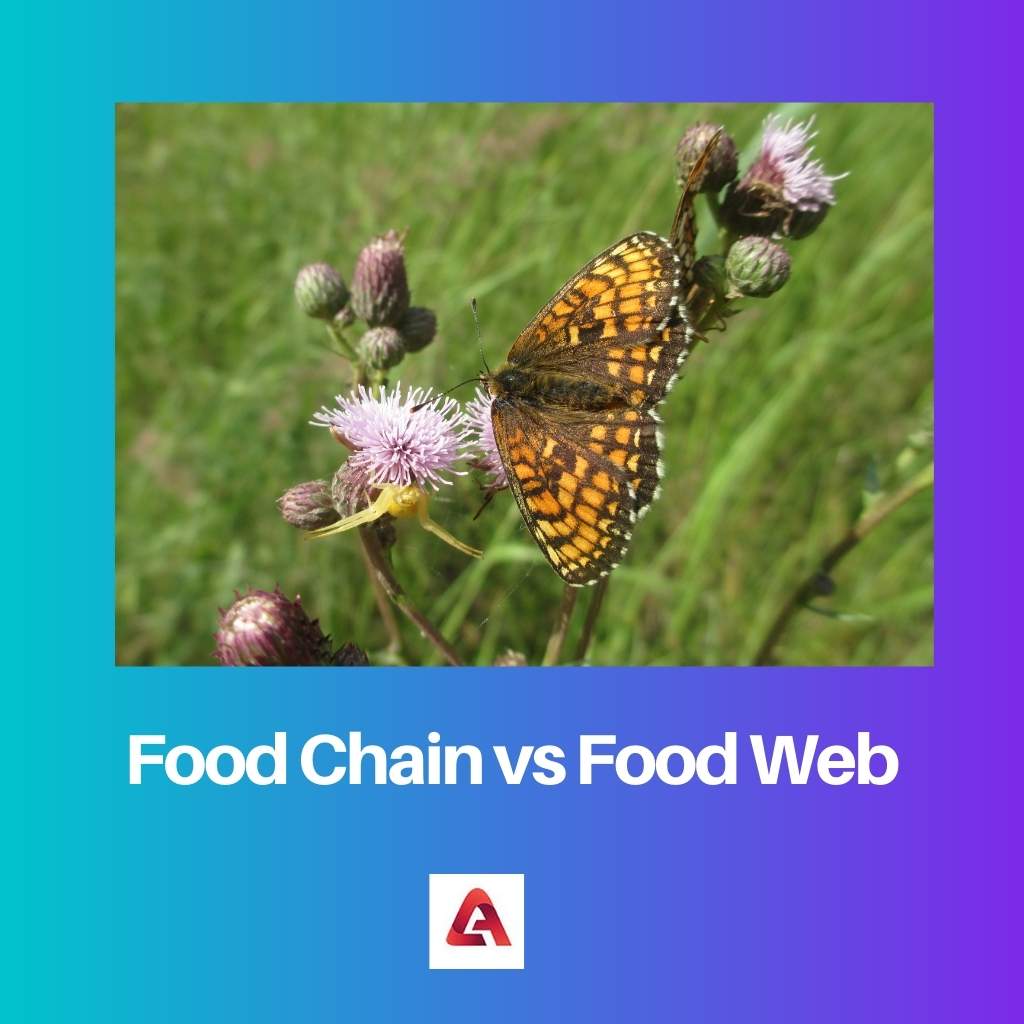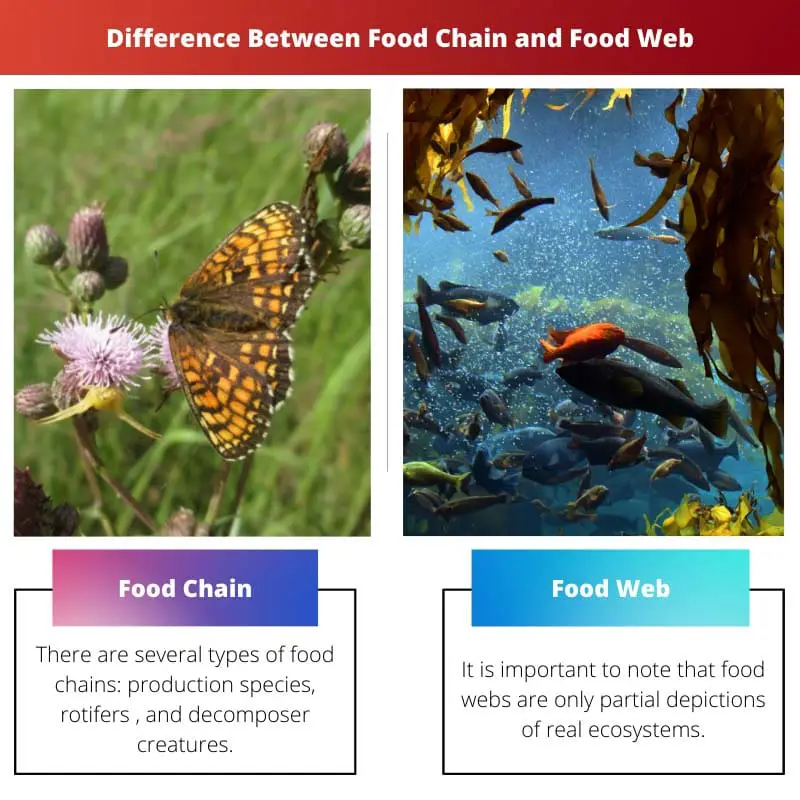When it comes to feeding any species in any habitat, there is just one thing that matters: energy. Energies can travel in a variety of directions, and the types of directions rely on several other elements.
A food chain, as well as a food web, is defined by how organisms utilize this resource and the routing energy follows from one creature to another.
Key Takeaways
- A food chain shows a linear relationship between organisms and their food sources, while a food web shows a complex network of relationships between multiple organisms and their food sources.
- A food chain is a simplified version of a food web, while a food web provides a more realistic representation of the interactions between organisms.
- A change in one part of a food web can have far-reaching effects on other parts, while a change in one part of a food chain has a more limited impact.
Food Chain vs Food Web
The food chain is a linear network of links that starts from the producer organisms and ends at the apex predator or decomposer species, showing how organisms are related by the food they eat. A food web is a graph and natural interconnection of all the food chains in a single ecosystem.

There are several types of food chains: production species (such as grass or shrubs that use solar energy to manufacture their sustenance), rotifers (such as insects or millipedes), and decomposer creatures (such as fungi or bacteria).
There is a trophic level for each rung of the food chain in the ecosystem.
It is important to note that food webs are only partial depictions of real ecosystems because they must coarse many life forms into trophic taxa or workable groups of organisms that share predators and pounce in the food web.
Comparison Table
| Parameters of Comparison | Food Chain | Food Web |
|---|---|---|
| Energy Flow | A Food Chain is an energy transfer diagram in the form of a straight line. | On the other hand, the energy flow is depicted by multiple connections in a food web. |
| Feeding Process | A higher-level trophic species relies on a lower-level trophic creature in a food Chain. | When an organism rises in the food web, it has more accessibility to resources that are available to those at a below trophic level. |
| Effect on Organisms | Food Chain has almost no impact on the flexibility and efficiency of organisms. | Food web contributes to an organism’s increased flexibility and efficiency. |
| Effect on Stability | A Food Chain exacerbates an ecosystem’s fragility. | On the other hand, a food web improves the ecosystem’s sustainability. |
| Pathway | To describe the linear movement of food molecules and the grazing interactions between creatures in an ecosystem, food chain uses trophic levels and shows them in series. | Whereas, food web is a visual representation of how food chains intertwine in a specific environmental region. |
What is Food Chain?
There are several types of food chains: production species (such as grass or shrubs that use solar energy to manufacture their sustenance), rotifers (such as insects or millipedes), and decomposer creatures (such as fungi or bacteria).
There is a trophic level for each rung of the food chain in the ecosystem.
Most organisms depend on food chains to survive. Occasionally, removing just one ingredient from the food supply chain might cause a species to go extinct.
First-tier farmers form the basis of the food chain. Because higher trophic levels can’t use energy from sunlight or inanimate chemical substances, they must devour providers or other organisms that ingest producers.
Almost all life would come to an end if the sunlight vanished, as its light is required for photosynthesis. Dead animal-consuming organisms convert organic molecules into simple nutrients that are buried in the ground.
For plants to produce organic substances, they need basic nutrients. And over 100,000 distinct decomposers are thought to exist.

What is Food Web?
It is important to note that food webs are only partial depictions of real ecosystems because they must coarse many life forms into trophic taxa or workable groups of organisms that share predators and pounce in the food web.
In quantification (or arithmetical portrayal) concepts of trophic or consumer-resource explicit measures, environmentalists use these approximations to reduce complexity.
To test for generalized trends in real food web networks, individuals can use these models.
Within the hierarchical model of food webs, conservationists have discovered properties that are not random. Meta-analyses rely on publication examples that are of varying quality and contain omissions.
Despite this, the number of research studies on com has increased dramatically.
The trophic levels and placements of food webs can be determined. In the first layer are just the fundamental species, like plants, which are resource-limited and eat nothing else on the web.
There are a variety of basal species, comprising autotrophs, decomposers, and disintegrating biological matter and its accompanying microbes, which were characterized as detritus and vasculature plant matter.

Main Differences Between Food Chain and Food Web
- A Food Chain is an energy transfer diagram in the form of a straight line. On the other hand, the energy flow is depicted by multiple connections in a food web.
- A higher-level trophic species relies on a lower-level trophic creature in a Food Chain. When an organism rises in the food web, it has more access to resources that are available to those at a below-trophic level.
- The Food Chain has almost no impact on the flexibility and efficiency of organisms. The Food web contributes to an organism’s increased flexibility and efficiency.
- A Food Chain exacerbates an ecosystem’s fragility. On the other hand, a food web improves the ecosystem’s sustainability.
- To describe the linear movement of food molecules and the grazing interactions between creatures in an ecosystem, the food chain uses trophic levels and shows them in series. In contrast, the food web is a visual representation of how food chains intertwine in a specific environmental region.

Last Updated : 30 August, 2023

Piyush Yadav has spent the past 25 years working as a physicist in the local community. He is a physicist passionate about making science more accessible to our readers. He holds a BSc in Natural Sciences and Post Graduate Diploma in Environmental Science. You can read more about him on his bio page.

What an engaging and well-researched article. The in-depth examination of why most organisms depend on food chains to survive is fascinating.
The explanation of trophic levels and the concept of energy flow in both food chains and food webs is exceptionally clear. I appreciate the level of detail included in this article.
The article does a great job of emphasizing the impact of a change in one part of a food web on other parts, helping readers understand the interconnectedness of different organisms.
I couldn’t agree more. The comprehensive breakdown of the main differences between food chains and food webs is enlightening and well-presented.
The detailed information provided about the role of dead animal-consuming organisms in sustaining ecosystems is truly eye-opening. It adds a whole new dimension to understanding food chains and food webs.
Totally agree with you. The discussions about the implications of food chains and food webs on species’ sustainability and ecosystem stability are captivating.
Absolutely, the article provides a compelling argument for the significance of food chains and food webs in maintaining ecological balance. Very informative.
The section explaining how food webs are partial depictions of real ecosystems due to the need to categorize life forms into trophic taxa is extremely interesting and adds depth to the discussion.
I found the insights into the various basal species marked by different trophic levels in food webs to be thought-provoking. It’s a fascinating aspect of ecosystem research.
Absolutely, and the concept of quantification of trophic or consumer-resource interactions in food webs is an intriguing approach to reducing complexity in environmental studies.
The comparison table neatly summarizes the key differences between food chains and food webs, making it much easier to comprehend the unique characteristics of each.
This article provides a thorough analysis and comparison of food chains and food webs, highlighting the significant impact of each on the ecosystem’s sustainability.
The section on the main differences between food chains and food webs is exceptionally well-articulated, making the complexities of both concepts much more accessible to a wider audience.
I couldn’t agree more. The author’s approach to explaining the pathways of food molecules and grazing interactions in ecosystems is truly commendable.
Absolutely, the article offers a comprehensive and thorough comparison between food chains and food webs, shedding light on their respective impacts on ecosystems.
The descriptions of the feeding process and the effects on organisms and stability of the ecosystem for both food chains and food webs are very insightful. I’ve learned a lot from this article.
I couldn’t agree more. The visual representation of how food chains intertwine in a specific environmental region is both captivating and educational.
Absolutely, the section on the impact of food chains and food webs on the flexibility and efficiency of organisms is an eye-opener. Great read!